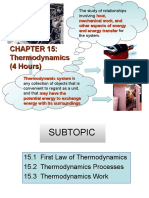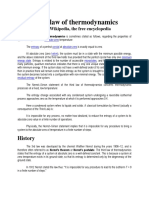Haber Process and Ammonia
Haber Process and Ammonia
Uploaded by
Aaron HongCopyright:
Available Formats
Haber Process and Ammonia
Haber Process and Ammonia
Uploaded by
Aaron HongOriginal Description:
Copyright
Available Formats
Share this document
Did you find this document useful?
Is this content inappropriate?
Copyright:
Available Formats
Haber Process and Ammonia
Haber Process and Ammonia
Uploaded by
Aaron HongCopyright:
Available Formats
Year 12 Chemistry Chemical Monitoring and Management
Haber Process and Ammonia
Ammonia
Identify and describe industrial uses of ammonia
Ammonia (NH3) is a common weak base used in the production of many products. It is used to:
Make fertilisers (Ammonium Sulfate, Ammonium Nitrate, Urea)
Create nitric acid, which is then used to create fertilisers, dyes, fibres, plastics and explosives such as TNT and
nitro-glycerine
Household detergents and cleaners
Production
Identify that ammonia can be synthesized from its component gases nitrogen and hydrogen
Describe that synthesis of ammonia occurs as a reversible reaction that will reach equilibrium
Identify the reaction of hydrogen with nitrogen as exothermic
Analyse the impact of increased pressure on the system involved in the Haber Process
The Haber process was the process to synthesise ammonia from nitrogen and hydrogen gas.
2() + 32() 23 ()
It is an exothermic reaction, releasing 46kJ per mole of Ammonia. [ = 46/]. It is also a reversible
reaction, forming an equilibrium. The standard equilibrium factors of pressure, temperature and concentration
apply.
To push the forward reaction, the optimal conditions will be low temperature and high pressure. High pressure
favours less moles on the forward side, while low temperature favours the forward as it removes excess heat
from the system
Rate of Reaction and The Balancing Act
Explain why the rate of reaction is increased by higher temperatures
Explain why the yield of a product in the Haber process is reduced at higher temperatures using Le Chateliers
principle
Explain why the Haber process is based on a delicate balancing act involving reaction energy, reaction rate and
equilibrium
A reaction occurs when two particles collide with one another AND they possess enough energy to surpass the
activation energy and begin the reaction. Because of this, the rate of reaction is based on the probability that two
particles collide with sufficient energy.
Referring back to the Kinetic Theory of Particles, gases consist of particles and heat energy correlates to kinetic
energy. The hotter a substance is, the higher its kinetic energy. Therefore with higher kinetic energy, the extra
movement increases the chance of collision as well as increasing the available energy available for the reaction,
thereby increasing the change that said collisions have enough energy to begin the activation. Overall this leads
to the conclusion that higher temperatures allow for higher rates of reaction.
Now with the Haber Process, to optimize yield, lower temperatures are favourable. But low temperatures give a
low rate of reaction. Therefore a compromise needs to be made to allow high enough rate of reaction such that
the equilibrium point is reached in a feasible amount of time, but the temperature will need to be low enough
such that the equilibrium point has a high enough yield to make the process viable.
From this the ideal conditions are 400oC and 2.5 x 104kPa. This produces an equilibrium of 45%.
Year 12 Chemistry Chemical Monitoring and Management
Catalyst
Explain that the use of a catalyst will lower the reaction temperature required and identify the catalysts used in
the Haber process
A method to help bypass this issue is to introduce the catalyst. The introduction of the catalyst does NOT increase
yield by directly shifting the equilibrium per se. It increases yield over time by allowing for higher rate of reactions
at lower temperatures.
The catalyst used is Magnetite, Fe3O4. It functions by providing a surface for the reaction to occur. It lowers the
energy required to being the activation, allowing the reaction to occur at lower temperatures, which in turn
increases yield.
The reason it does not shift the equilibrium directly is because it speeds up both the forward and backwards
reactions.
Monitoring of the Reaction Vessel
Explain why monitoring of the reaction vessel used in the Haber process is crucial discuss monitoring required
Many different conditions must be maintained for efficient and safe operation of the Haber process. They are as
follows:
Temperature/Pressure: Needs to be kept at the optimal range to maximized efficiency and yield. Also
excessive temperatures will damage the catalyst.
Ratio of H2 to N2: The build up of one reactant will slow the process.
Concentrations of O2, CO, CO2, and Sulfur compounds in incoming gas
o The presence of oxygen creates the risk of explosion
o The other gases position the catalyst
Concentration of Argon and Methane: lowers efficiency
Historical Significance of the Haber Process
Gather and process information from secondary sources to describe the conditions developed the industrial
synthesis and evaluate its significance at that time in world history
The Haber process was developed by the German, Fritz Haber. It was developed at the beginning of the 20th
century, leading up to WW1. Growing world populations was placing more strain on finite Nitrate resources.
Germanys growing military presence promoted explosives production, placing further demand for natural nitrate
resources. The Haber process helped to alleviate these pressures, providing a method to artificially create
ammonia which could be used to produce nitrate.
In 1908 Haber develops a catalytic method of synthesising Ammonia. It would be further improved with the help
of Carl Bosch to industrialise the process in 1914.
The process was significant as during WW1, the Allies blocked nitrate imports into Germany. This starved the
populace and halted the production of explosives. The Haber process enabled Germany to continue production
and fertilisers and explosives, sustaining Germanys war effort and prolonging the war.
The principle of the process would also later lead to the synthesis of other products, e.g. methyl alcohol,
hydrogenation of coal.
You might also like
- Forza XADV 750 - 2021 Honda Smartkey Wiring Diagram SystemDocument23 pagesForza XADV 750 - 2021 Honda Smartkey Wiring Diagram SystemAny TimNo ratings yet
- Chapter 1 Capstone Case: New Century Wellness GroupDocument4 pagesChapter 1 Capstone Case: New Century Wellness GroupJC100% (8)
- As 1055-2018Document57 pagesAs 1055-2018Aaron Hong100% (1)
- The Original Backnobber II Tool: User GuideDocument37 pagesThe Original Backnobber II Tool: User GuideAl BnNo ratings yet
- Volume 2 of 3 (Substation Part)Document539 pagesVolume 2 of 3 (Substation Part)Pranoy BaruaNo ratings yet
- Heat 4e Chap04 LectureDocument39 pagesHeat 4e Chap04 Lectureehdfhdhdfhdh100% (1)
- KJM4120 Ch3 Defect EquilibriaDocument31 pagesKJM4120 Ch3 Defect EquilibriaMohamed Elsherif100% (1)
- Me 2202 Engineering ThermodynamicsDocument2 pagesMe 2202 Engineering ThermodynamicsDinesh MechNo ratings yet
- Kahn 1971 AIA Gold MedalDocument9 pagesKahn 1971 AIA Gold MedalAaron HongNo ratings yet
- STEARNS - Encyclopedia of European Social History (From 1350 To 2000) PDFDocument2,988 pagesSTEARNS - Encyclopedia of European Social History (From 1350 To 2000) PDFPopescuAnamariaNo ratings yet
- The Haber and Contact ProcessesDocument3 pagesThe Haber and Contact Processesjavison_501100% (1)
- Thermodynamics Imp ListDocument4 pagesThermodynamics Imp Listvenkat乡MPL 乡No ratings yet
- MMS Unit 2 Phase DiagramsDocument35 pagesMMS Unit 2 Phase DiagramsPraveen KolukulaNo ratings yet
- Contact ProcessDocument23 pagesContact ProcessLalitha KurumanghatNo ratings yet
- S4 Thermodynamics PQPDocument16 pagesS4 Thermodynamics PQPAltros mNo ratings yet
- MET 202 Thermodynamics - Module 2Document50 pagesMET 202 Thermodynamics - Module 2Farzeen FirozNo ratings yet
- Bme NotesDocument44 pagesBme Notestempoterrace2306No ratings yet
- Chapter-9 - THERMODYNAMICSDocument37 pagesChapter-9 - THERMODYNAMICSJoanne SohNo ratings yet
- Unit 1-2Document80 pagesUnit 1-2Shambhavi LeolineLeveretNo ratings yet
- r05220802 Chemical Engineering Thermodynamics IDocument6 pagesr05220802 Chemical Engineering Thermodynamics ISRINIVASA RAO GANTANo ratings yet
- Unit-8 Shear Stress in BeamsDocument25 pagesUnit-8 Shear Stress in BeamsBharath KaipparedanNo ratings yet
- Second Law of ThermodynamicsDocument10 pagesSecond Law of ThermodynamicsDAVIDNo ratings yet
- 6 Numerical Methods 2 False Position and SecantDocument15 pages6 Numerical Methods 2 False Position and SecantCarl PNo ratings yet
- Principle of Virtual Work and D'Alembert's PrincipleDocument10 pagesPrinciple of Virtual Work and D'Alembert's PrincipleKristine Rodriguez-CarnicerNo ratings yet
- Thermo - First Second LawDocument35 pagesThermo - First Second LawPengintaiNo ratings yet
- 1 Laplace Transforms - Notes PDFDocument16 pages1 Laplace Transforms - Notes PDFSboNo ratings yet
- Units and Measurements CH2Document57 pagesUnits and Measurements CH2Rishab SharmaNo ratings yet
- Third Law of ThermodynamicsDocument8 pagesThird Law of ThermodynamicsJonalyn Rey100% (1)
- Material ScienceDocument55 pagesMaterial ScienceAnas MuhammedNo ratings yet
- Thermodynamics I CH - 3 - Pure-SubstanceDocument46 pagesThermodynamics I CH - 3 - Pure-SubstancemathewosNo ratings yet
- Engg Thermodynamics PDFDocument44 pagesEngg Thermodynamics PDFBrandon FunaNo ratings yet
- Electrochemistry and ThermodynamicsDocument7 pagesElectrochemistry and ThermodynamicsAhmadPraboeNo ratings yet
- Catenation PDFDocument2 pagesCatenation PDFAli AyanNo ratings yet
- Problems On Clausius Clayperon EqnDocument5 pagesProblems On Clausius Clayperon EqnAkshat RawatNo ratings yet
- Chapter Two: Properties of Pure SubstanceDocument53 pagesChapter Two: Properties of Pure SubstanceHabtamu Tkubet EbuyNo ratings yet
- Taylor's and Power Series Method For Solving ODEDocument5 pagesTaylor's and Power Series Method For Solving ODEAhmed Wael RadwanNo ratings yet
- Secondary CellDocument10 pagesSecondary Celladventa sinta maritoNo ratings yet
- B3B032 Total Pages:2: (Answer Any Two Questions)Document11 pagesB3B032 Total Pages:2: (Answer Any Two Questions)Sourabh PradhanNo ratings yet
- Unit - 2: Derivation of Shear Stress Produced in A Circular Shaftsubjected To TorsionDocument13 pagesUnit - 2: Derivation of Shear Stress Produced in A Circular Shaftsubjected To TorsionKomalaselvan VNo ratings yet
- Thermodynamics PDFDocument122 pagesThermodynamics PDFPrateek Srivastava100% (1)
- The Second Law of ThermodynamicsDocument29 pagesThe Second Law of Thermodynamicsbenson100% (1)
- Ktu Me Engineering Thermodynamics Previous Year Papers SolvedDocument72 pagesKtu Me Engineering Thermodynamics Previous Year Papers SolvedemlinvNo ratings yet
- Phasor DiagramDocument10 pagesPhasor Diagram10rodriguezNo ratings yet
- Phase DiagramsDocument39 pagesPhase DiagramsLeo Dev WinsNo ratings yet
- Short Questions Chapter No. 3. FSC Physics First YeardocDocument4 pagesShort Questions Chapter No. 3. FSC Physics First Yeardocmuzammalsafdar100% (2)
- Ficks LawDocument9 pagesFicks LawramjidrNo ratings yet
- 2018 Tutorial - Heat and Thermodynamics (MCQ)Document7 pages2018 Tutorial - Heat and Thermodynamics (MCQ)Mmeli NtwanaYebhoza DubeNo ratings yet
- Electrochemical CellDocument30 pagesElectrochemical CellSubhu100% (1)
- 14thermal Expansion of Materials - 227-249Document11 pages14thermal Expansion of Materials - 227-249KAMAL KANT KUSHWAHANo ratings yet
- Thermal PropertiesDocument73 pagesThermal PropertiesdhrubankaNo ratings yet
- Photo ChemistryDocument25 pagesPhoto ChemistryBapu ThoratNo ratings yet
- Solubility CurvesDocument37 pagesSolubility Curvesapi-298247873100% (1)
- Chapter 6. ThermodynamicsDocument7 pagesChapter 6. Thermodynamicshoney1002No ratings yet
- Ternary Phase Diagrams IntroductionDocument41 pagesTernary Phase Diagrams IntroductionGikiTopiNo ratings yet
- Unit II - Chemical ThermodynamicsDocument26 pagesUnit II - Chemical ThermodynamicshvacsriniNo ratings yet
- Lebanese International University School of EngineeringDocument12 pagesLebanese International University School of EngineeringHassan RashedNo ratings yet
- TD-lecture NotesDocument135 pagesTD-lecture NotesAbdelkader Faklani Dou100% (1)
- IX - InTSO - Worksheet - 1 (Atoms & Molecules)Document3 pagesIX - InTSO - Worksheet - 1 (Atoms & Molecules)arush0156No ratings yet
- Van Der Waals ForcesDocument2 pagesVan Der Waals ForcesManP13100% (1)
- Phase Equilibrium Diagram': Phase, Phase Transformation, Phase Diagram, Phase Rule & Degress of FreedomDocument20 pagesPhase Equilibrium Diagram': Phase, Phase Transformation, Phase Diagram, Phase Rule & Degress of FreedomGlesie Devara CabacangNo ratings yet
- Physical Chemistry Reviewer - Laws of ThermodynamicsDocument2 pagesPhysical Chemistry Reviewer - Laws of ThermodynamicsJerome SadudaquilNo ratings yet
- Introductory Applications of Partial Differential Equations: With Emphasis on Wave Propagation and DiffusionFrom EverandIntroductory Applications of Partial Differential Equations: With Emphasis on Wave Propagation and DiffusionNo ratings yet
- Nonlinear Dynamic in Engineering by Akbari-Ganji’S MethodFrom EverandNonlinear Dynamic in Engineering by Akbari-Ganji’S MethodNo ratings yet
- Literature Review Ema CpdicDocument5 pagesLiterature Review Ema CpdicHemavathy RtNo ratings yet
- Core Topic 3 - Chemical Monitoring and ManagementDocument20 pagesCore Topic 3 - Chemical Monitoring and ManagementD RayNo ratings yet
- Well Minimum RequirementsDocument23 pagesWell Minimum RequirementsAaron HongNo ratings yet
- Eis TM Noise Measurement ManualDocument33 pagesEis TM Noise Measurement ManualAaron HongNo ratings yet
- Geosciences 09 00362Document19 pagesGeosciences 09 00362Aaron HongNo ratings yet
- 17p0543 Guide To Noise Policy For IndustryDocument11 pages17p0543 Guide To Noise Policy For IndustryAaron HongNo ratings yet
- Interim Construction Noise GuidelineDocument62 pagesInterim Construction Noise GuidelineAaron HongNo ratings yet
- c12 Noise and VibrationDocument13 pagesc12 Noise and VibrationAaron HongNo ratings yet
- 17p0279 Faq Noise Policy For IndustryDocument6 pages17p0279 Faq Noise Policy For IndustryAaron HongNo ratings yet
- Geology and Artesian Water Supply Grand Junction Area ColoradoDocument157 pagesGeology and Artesian Water Supply Grand Junction Area ColoradoAaron HongNo ratings yet
- GeoCharacterization 2013 Notes - Newcastle ExcerptDocument8 pagesGeoCharacterization 2013 Notes - Newcastle ExcerptAaron HongNo ratings yet
- 1962 PaperDocument7 pages1962 PaperAaron HongNo ratings yet
- Burns & Mayne 1998 ISC - DissipationDocument8 pagesBurns & Mayne 1998 ISC - DissipationAaron HongNo ratings yet
- PH Curves: Aliquot Solution Burette Solution Starting PH Ending PH Equivalence Point PHDocument2 pagesPH Curves: Aliquot Solution Burette Solution Starting PH Ending PH Equivalence Point PHAaron HongNo ratings yet
- Cathode Rays - Wave Particle DebateDocument8 pagesCathode Rays - Wave Particle DebateAaron HongNo ratings yet
- Pravesh Niti 2023-24Document39 pagesPravesh Niti 2023-24thelaksh890No ratings yet
- Screenshot 2024-03-12 at 11.50.15 PMDocument1 pageScreenshot 2024-03-12 at 11.50.15 PMDarshan BavaliyaNo ratings yet
- Prem Satin EnamelDocument1 pagePrem Satin EnamelShashank AgarwalNo ratings yet
- 4 World Ayurveda Congress: Guided byDocument40 pages4 World Ayurveda Congress: Guided bydrkartikeytyagiNo ratings yet
- Samsung Sv5000W-1 PDFDocument103 pagesSamsung Sv5000W-1 PDFsigi_204No ratings yet
- Pc-I Proforma Technical Assistance For Punjab Devolved Social Services ProgrammeDocument13 pagesPc-I Proforma Technical Assistance For Punjab Devolved Social Services ProgrammeNatasha Chaudhry SahibaNo ratings yet
- Subaru Impreza WRX 08-13 ManualDocument408 pagesSubaru Impreza WRX 08-13 Manualnicholas adhytia riantoNo ratings yet
- The Knee and The Cruciate Ligaments Anatomy Biomechanics Clinical Aspects Reconstruction Complications Rehabilitation by H.-U. Stäubli, R. P. Jakob (Auth.), Prof. Dr. R. P. Jakob, PD Dr. H.-U. StäuDocument633 pagesThe Knee and The Cruciate Ligaments Anatomy Biomechanics Clinical Aspects Reconstruction Complications Rehabilitation by H.-U. Stäubli, R. P. Jakob (Auth.), Prof. Dr. R. P. Jakob, PD Dr. H.-U. StäuemilNo ratings yet
- Doj Department Circular No 40 - 10Document3 pagesDoj Department Circular No 40 - 10Wednesday AbelgasNo ratings yet
- Confidentiality of Professional CommunicationDocument3 pagesConfidentiality of Professional CommunicationShenna RegaspiNo ratings yet
- EPA2008-Indoor Air Vapor Intrusion Mitigation ApproachesDocument49 pagesEPA2008-Indoor Air Vapor Intrusion Mitigation Approacheskulov1592100% (1)
- 8 Milk and Dairy ProductsDocument25 pages8 Milk and Dairy ProductsEdwar JpNo ratings yet
- Chap 021Document10 pagesChap 021Ondape ValeryNo ratings yet
- 2017092016131920170516140747KLS7 KW10Document5 pages2017092016131920170516140747KLS7 KW10Eazhil PreethiNo ratings yet
- 2011 - Census 2725 - PART - B - DCHB - PUNE - 4 PDFDocument100 pages2011 - Census 2725 - PART - B - DCHB - PUNE - 4 PDFTejjal PatelNo ratings yet
- Expanded Program On ImmunizationDocument7 pagesExpanded Program On ImmunizationGLadys Gegare100% (1)
- CA - Teach Me How To Fish PleaseDocument18 pagesCA - Teach Me How To Fish Pleasekhadeejath azniNo ratings yet
- Review Text Himalaya MaskDocument2 pagesReview Text Himalaya MaskBaeki ChanNo ratings yet
- Quality Solutions: ISO 9001: 2015 Quality Management SystemDocument9 pagesQuality Solutions: ISO 9001: 2015 Quality Management SystemOsman AitaNo ratings yet
- HR Domain NotesDocument18 pagesHR Domain NotesMonika ShindeyNo ratings yet
- 6 Best Colognes For Men in 2024 Discover MagaziDocument1 page6 Best Colognes For Men in 2024 Discover MagaziRabihNo ratings yet
- WEG Eletric Circuit and Motor Switching and Protection Guide 50110648 enDocument56 pagesWEG Eletric Circuit and Motor Switching and Protection Guide 50110648 enLucio SalesNo ratings yet
- Hudak DevelopmentofanUpperExtremityOutcomeMeasure-DASHDocument10 pagesHudak DevelopmentofanUpperExtremityOutcomeMeasure-DASHRossana CustodioNo ratings yet
- Ti110fen fmg573 dg57Document12 pagesTi110fen fmg573 dg57antonypallanNo ratings yet
- U Wpath Plus Report Plus and Plus FilesDocument242 pagesU Wpath Plus Report Plus and Plus FilesAdan Salazar0% (1)








































































































